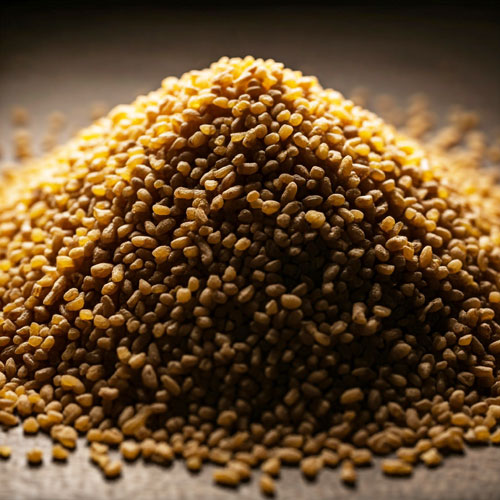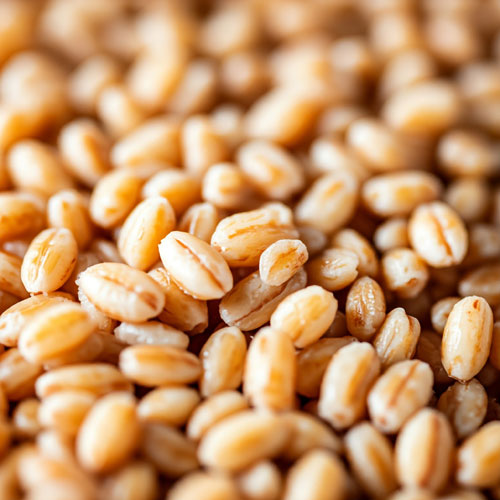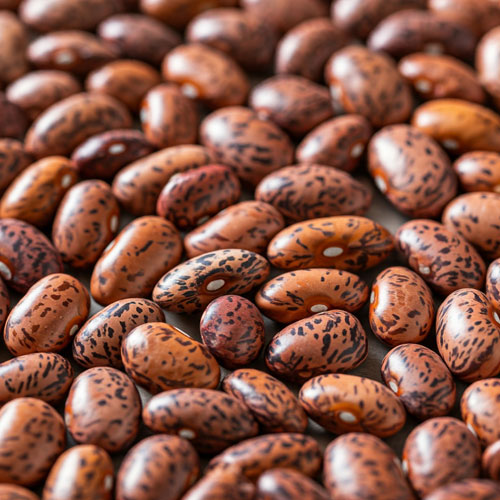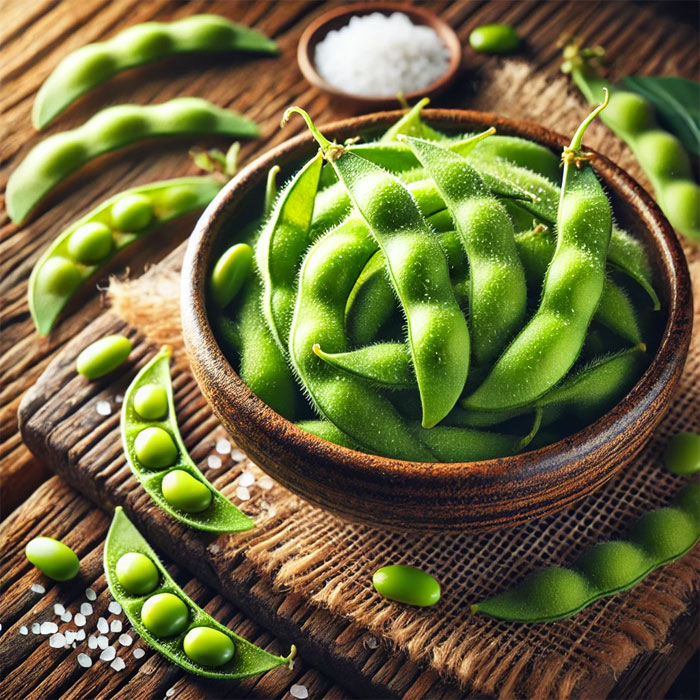Fibre is essential to a healthy, balanced diet, yet many people in the UK don’t consume enough of it. A fibre-rich diet benefits from maintaining overall health, helping with digestion, managing weight, and reducing the risk of several diseases.
In this blog, we will explore why fibre is important and highlight some of the best fibre-rich foods that you can easily incorporate into your meals.
Key Takeaways:
- • Fibre plays a crucial role in supporting heart health, blood sugar control, digestion, and weight management.
- • Adults in the UK should consume at least 30 grams of fibre per day.
- • Incorporating a variety of vegetables, whole grains, fruits, legumes, nuts, and seeds into your meals is an easy way to increase your daily fibre.
Why Fibre is Essential for Your Health
- • Promotes Digestive Health: Fibre adds bulk to your stool, helping to prevent constipation and keep your digestive system running smoothly.
- • Lowers Cholesterol Levels: Soluble fibre helps reduce LDL cholesterol levels, supporting heart health and lowering the risk of heart disease.
- • Helps Control Blood Sugar Levels: Fibre slows sugar absorption, helping maintain stable blood sugar levels, which is especially important for people with diabetes.
- • Supports Weight Management: High-fibre foods help you feel full longer, aiding in weight control by reducing overall calorie intake.
Recommended Daily Fibre Intake
The recommended fibre dosage for adults in the UK is 30 grams daily. However, many people fall short of this target, consuming only about 20 grams daily on average. Increasing your intake of fibre-rich foods is one of the easiest ways to improve your overall health. You can easily meet the recommended daily amount by making simple swaps in your diet-such as choosing whole grains over refined grains or adding more fruits and vegetables to your meals.
Top Fibre-Rich Foods to Include in Your Diet
To help you hit your fibre goals, here’s a fibre-rich foods list that you can easily incorporate into your meals:
1. Whole Grains
Whole grains are a great source of fibre, providing essential nutrients and complex carbohydrates that promote digestive health and keep you fuller for longer. They are versatile and can be used in a variety of dishes, making them easy to incorporate into your daily diet. Here is the list of whole grains to include in your meals for a healthy fibre intake:
-
• Brown Rice
- • Fibre content: 1.6 grams per 100 grams.
- • Brown rice is a whole grain that retains its bran layer, providing more fibre than white rice. It’s versatile and works well in many dishes, from stir-fries to salads.
-
• Quinoa
- • Fibre content: 2.8 grams per 100 grams.
- • Quinoa is a gluten-free pseudo-grain rich in fibre and complete protein, making it a popular choice for those looking to boost fibre and nutrients.
-
• Bulgur
- • Fibre content: 4.5 grams per 100 grams.
- • A staple in Mediterranean cuisine, bulgur is quick to cook and makes a delicious base for salads and grain bowls.
-
• Millet
- • Fibre content: 1.3 grams per 100 grams.
- • A lesser-known but highly nutritious grain, millet is easy to digest and can be used in porridge or as a side dish.
-
• Farro
- • Fibre content: 6.6 grams per 100 grams.
- • Farro is an ancient grain with a nutty flavour and a chewy texture, making it a satisfying addition to soups and salads.
-
• Rye Bread
- • Fibre content: 5.8 grams per slice.
- • Rye bread is dense, hearty, and contains significantly more fibre than standard white or wheat bread.


2. Fruits
Fruits are a naturally delicious way to increase fibre intake while providing essential vitamins, minerals, and antioxidants. Incorporating a variety of fruits into your diet can help you meet your daily fibre requirements. Here is a list of fibre-rich fruits to include in your meals and snacks for better digestive health and overall well-being:
- • Bananas
- • Fibre content: 2.6 grams per medium banana.
- • Bananas are rich in soluble fibre and provide a quick, convenient energy source.
- • Oranges
- • Fibre content: 3 grams per medium orange.
- • Oranges are packed with vitamin C and are a refreshing, high-fibre fruit perfect for snacks or breakfast.
- • Avocados
- • Fibre content: 10 grams per medium avocado.
- • Avocados are a great source of healthy fats and contain a substantial amount of fibre, making them a superfood for heart health.
- • Strawberries
- • Fibre content: 2 grams per 100 grams.
- • Strawberries are low in calories but high in fibre, vitamins, and antioxidants.
- • Figs
- • Fibre content: 2.9 grams per 100 grams (fresh).
- • Whether fresh or dried, figs are sweet and fibre-rich, ideal for snacking or adding to salads.
- • Blackberries
- • Fibre content: 5.3 grams per 100 grams.
- • Blackberries are one of the highest-fibre fruits and are rich in antioxidants, making them a perfect addition to smoothies or yoghurt.
3. Vegetables
Vegetables are amazing sources of both soluble and insoluble fibre, essential for promoting digestive health and overall well-being. Including a wide variety of fibre-rich vegetables in your diet supports gut health and provides a range of vitamins, minerals, and antioxidants. Below is a list of high-fibre vegetables that can easily be incorporated into your meals for a balanced and nutritious diet:
- • Sweet Potatoes
- • Fibre content: grams per 100 grams.
- • Sweet potatoes are a nutrient powerhouse containing soluble and insoluble fibre, promoting gut health.
- • Spinach
- • Fibre content: 2.2 grams per 100 grams.
- • Spinach is a leafy green packed with fibre, vitamins, and minerals, perfect for salads or as a side.
- • Kale
- • Fibre content: 4.1 grams per 100 grams.
- • Kale is a highly nutritious green rich in fibre and antioxidants, perfect for salads, smoothies, or sautéed.
- • Cauliflower
- • Fibre content: 2 grams per 100 grams.
- • Cauliflower is an excellent vegetable that’s low in calories and high in fibre. Use it to make mash, rice, or even pizza crust.
- • Artichokes
- • Fibre content: 5.4 grams per medium artichoke.
- • Artichokes are among the most fibre-rich vegetables, and their high content supports digestive health.
- • Green Peas
- • Fibre content: 5.7 grams per 100 grams.
- • Green peas are a great plant-based protein and fibre source, ideal for soups and side dishes.
- • Asparagus
- • Fibre content: 2.1 grams per 100 grams.
- • Asparagus is a low-calorie, high-fibre vegetable that is simple to roast, steam, or include in salads.
4. Legumes
Legumes are a fantastic source of fibre, protein, and other essential nutrients, making them a staple for many healthy diets. Adding a variety of legumes to your meals can significantly boost your fibre intake while supporting heart health and maintaining balanced blood sugar levels. Here is a list of fibre-rich legumes that can easily be incorporated into stews, soups, salads, and more for a nutrient-dense, satisfying meal:
- • Black-eyed Peas
- • Fibre content: 8.3 grams per 165 grams.
- • Black-eyed peas are nutrient-dense and high in fibre, perfect for stews and salads.
- • Kidney Beans
- • Fibre content: 7.4 grams per 100 grams.
- • Kidney beans are a classic addition to chilli and soups, providing great dietary fibre.
- • Pinto Beans
- • Fibre content: 9 grams per 100 grams.
- • Pinto beans are popular in Mexican cuisine and are one of the most fibre-rich legumes.
- • Edamame
- • Fibre content: 5 grams per 100 grams.
- • Edamame are young soybeans that provide fibre and protein, making them an excellent snack or addition to stir-fries.
- • Navy Beans
- • Fibre content:7.9 grams per 100 grams.
- • Navy Beans are quick to cook and can be used in various dishes, including soups and salads.
- • Chickpeas
- • Fibre content: 7.6 grams per 100 grams.
- • Chickpeas are versatile and can be used in salads, curries, and hummus, providing a good fibre source.



5. Nuts and Seeds
Nuts and seeds are not only delicious snacks but also packed with fibre, healthy fats, and protein. Including a variety of nuts and seeds in your diet can help improve overall health and support digestive function. Here is a list of high-fibre nuts and seeds that can easily be added to your meals or enjoyed as snacks:
- • Chia Seeds
- • Fibre content: 34.4 grams per 100 grams.
- • Chia seeds are incredibly high in fibre and can be added to smoothies, oatmeal, or used to make chia pudding.
- • Flaxseeds
- • Fibre content: 27.3 grams per 100 grams.
- • Flaxseeds are another excellent source of fibre and can be easily incorporated into baked goods or smoothies.
- • Almonds
- • Fibre content: 12.5 grams per 100 grams.
- • Almonds are a nutritious snack high in fibre and healthy fats.
- • Pistachios
- • Fibre content: 10.6 grams per 100 grams.
- • Pistachios are a tasty and nutritious nut option that can help boost your fibre intake.
- • Walnuts
- • Fibre content: 6.7 grams per 100 grams.
- • Walnuts are rich in omega-3 fatty acids and provide a decent amount of fibre.
- • Sunflower Seeds
- • Fibre content: 8.6 grams per 100 grams.
- • Sunflower seeds are great as a snack or added to salads, providing fibre and healthy fats.
Conclusion
Incorporating fibre-rich foods such as whole grains, fruits, vegetables, legumes, nuts, and seeds into your diet is a straightforward and effective way to enhance your overall well-being. These nutrient-dense foods promote digestive health, support heart health, help regulate blood sugar levels, and assist in weight management. A diet rich in natural fibre can also lower the risk of developing chronic conditions, such as type 2 diabetes and cardiovascular disease, while keeping your digestive system functioning smoothly.
If you aim to increase your fibre intake or struggle to meet the recommended daily amounts through food alone, consider exploring the range of fibre supplements available at Nature’s Fix. You’ll find supplements from trusted and reputable brands at Nature’s Fix, ensuring quality and reliability. These supplements can provide a convenient solution to help you meet your daily fibre needs, supporting your journey to a healthier lifestyle.
FAQs
1. How much fibre should I consume daily?
According to NHS guidelines in the UK, adults should aim to consume at least 30 grams of fibre each day. However, most people fall short of this, averaging around 20 grams. Increasing your intake of fibre-rich foods such as whole grains, fruits, vegetables, and legumes can help you reach the recommended daily amount.
2. Why is fibre important for my health?
Fibre plays a critical role in maintaining overall health. It promotes healthy digestion, helps control blood sugar levels, reduces cholesterol, and aids in weight management by helping you feel full for longer. A fibre-rich diet is also linked to a reduced risk of diseases like heart disease, stroke, and type 2 diabetes.
3. What are some easy ways to add more fibre to my diet?
To boost your fibre intake, try these simple swaps:
- • Choose whole-grain versions of bread, pasta, and rice.
- • Snack on fruits like bananas, apples, and oranges instead of processed snacks.
- • Add fibre-rich vegetables such as spinach, sweet potatoes, and cauliflower to your meals.
- • Incorporate legumes like lentils, kidney beans, or chickpeas into soups, salads, and stews.
- • Snack on nuts and seeds like cashews, sunflower seeds, or pumpkin seeds.
4. What’s the difference between soluble and insoluble fibre?
Soluble fibre dissolves in water to form a gel-like substance, which helps lower cholesterol and control blood sugar levels. Good sources include oats, beans, and fruits like apples and bananas. Insoluble fibre adds bulk to the stool, aiding digestion and preventing constipation. It’s found in foods like whole grains, nuts, and vegetables.
5. Can a high-fibre diet help with weight loss?
Yes, a diet rich in fibre can assist with weight management. High-fibre foods help you feel fuller for longer, reducing the likelihood of overeating. Since fibre-rich foods tend to be less calorie-dense but more filling, they can support weight loss by reducing overall calorie intake.
6. Are there any risks of consuming too much fibre?
While fibre is essential for health, consuming too much fibre, especially too quickly, can lead to digestive issues like bloating, gas, and constipation. It is important to increase your fibre intake gradually and drink plenty of water to help your digestive system adjust.
7. Which fruits are highest in fibre?
Fibre-rich fruits include:
- • Avocados (10 grams per medium avocado)
- • Blackberries (5.3 grams per 100 grams)
- • Figs (2.9 grams per 100 grams)
- • Bananas (2.6 grams per medium banana)
These fruits boost your fibre intake and provide important vitamins and antioxidants.
8. Can fibre supplements replace natural fibre from food?
While fibre supplements can be a helpful addition for those struggling to meet their daily needs through food alone, it’s best to get most of your fibre from whole foods. Whole foods provide additional nutrients such as vitamins, minerals, and antioxidants that supplements don’t offer. However, if you find it difficult to consume enough fibre, quality supplements from reputable brands can help bridge the gap.
9. Are there any fibre-rich foods suitable for people with gluten intolerance?
Several gluten-free foods are fibre-rich, including quinoa, brown rice, millet, and fruits like avocados and blackberries. Legumes such as chickpeas, lentils, nuts, and seeds like cashews and sunflower seeds are also excellent gluten-free, fibre-rich options.
10. How can I track my fibre intake?
You can use food tracking apps or keep a food diary to track your fibre intake. Pay attention to food labels when shopping, as they often provide the fibre content per serving. Ensuring a variety of fibre-rich foods such as whole grains, fruits, vegetables, and legumes in each meal will help you reach the recommended daily intake of 30 grams.
References:
1- https://www.nutrition.org.uk/nutritional-information/fibre/
2 – https://www.mayoclinic.org/healthy-lifestyle/nutrition-and-healthy-eating/in-depth/fiber/art-20043983
3 – https://www.mayoclinic.org/diseases-conditions/high-blood-cholesterol/in-depth/cholesterol/art-20045192
4 – https://www.cdc.gov/diabetes/healthy-eating/fiber-helps-diabetes.htm
5 – https://www.medicalnewstoday.com/articles/146935
6 – https://www.nhs.uk/live-well/eat-well/digestive-health/how-to-get-more-fibre-into-your-diet/
7 – https://www.nutrition.org.uk/nutritional-information/fibre/
8 – https://nutritionsource.hsph.harvard.edu/what-should-you-eat/whole-grains/
9 – https://www.ncbi.nlm.nih.gov/pmc/articles/PMC3649719/
10 – https://www.ncbi.nlm.nih.gov/pmc/articles/PMC9370574/
11 – https://www.ncbi.nlm.nih.gov/pmc/articles/PMC3257681/
12 – https://www.healthline.com/nutrition/brown-vs-white-rice#brown-rice
13 – https://fdc.nal.usda.gov/fdc-app.html#/food-details/168917/nutrients
14 – https://en.wikipedia.org/wiki/Bulgur
15 – https://www.medicalnewstoday.com/articles/what-is-millet#nutritional-facts
16 – https://fdc.nal.usda.gov/fdc-app.html#/food-details/1899570/nutrients
17 – https://www.fatsecret.com/calories-nutrition/usda/rye-bread?portionid=61545&portionamount=100.000
18 – https://www.healthline.com/nutrition/22-high-fiber-foods#types-of-fiber
19 – https://www.webmd.com/food-recipes/health-benefits-oranges
20 – https://nutritionsource.hsph.harvard.edu/avocados/
21 – https://www.healthline.com/nutrition/22-high-fiber-foods#22-high-fiber-foods
22 – https://fdc.nal.usda.gov/fdc-app.html#/food-details/173021/nutrients
23 – https://www.healthline.com/nutrition/22-high-fiber-foods
24 – https://www.healthline.com/nutrition/22-high-fiber-foods
25 – https://www.healthline.com/nutrition/22-high-fiber-foods
26 – https://www.healthline.com/nutrition/22-high-fiber-foods
27 – https://www.webmd.com/food-recipes/health-benefits-cauliflower
28 – https://www.healthline.com/nutrition/22-high-fiber-foods
29 – https://fitaudit.com/food/120461
30 – https://www.soupersage.com/compare-nutrition/asparagus-vs-spinach
31 – https://www.medicalnewstoday.com/articles/black-eyed-peas-nutrition#nutrition
32 – https://www.healthline.com/nutrition/22-high-fiber-foods
33 – https://www.medicalnewstoday.com/articles/323133
34- https://www.healthline.com/nutrition/22-high-fiber-foods
35 – https://www.medicalnewstoday.com/articles/323133
36 – https://www.medicalnewstoday.com/articles/323133
37 – https://www.healthline.com/nutrition/22-high-fiber-foods
38 – https://www.healthline.com/nutrition/22-high-fiber-foods
39 – https://www.healthline.com/nutrition/22-high-fiber-foods
40 – https://www.healthline.com/nutrition/22-high-fiber-foods
41 – https://fdc.nal.usda.gov/fdc-app.html#/food-details/170581/nutrients
42 – https://fdc.nal.usda.gov/fdc-app.html#/food-details/170162/nutrients
43 – https://www.cdc.gov/diabetes/healthy-eating/fiber-helps-diabetes.html
44 – https://www.betterhealth.vic.gov.au/health/healthyliving/fibre-in-food
45 – https://www.mayoclinic.org/healthy-lifestyle/nutrition-and-healthy-eating/in-depth/fiber/art-20043983
46 – https://www.betterhealth.vic.gov.au/health/healthyliving/fibre-in-food
47 – https://www.mayoclinic.org/healthy-lifestyle/nutrition-and-healthy-eating/in-depth/fiber/art-20043983






